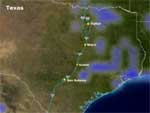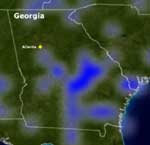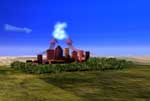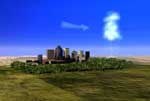June 18, 2002 -(date of web publication)
NASA SATELLITE CONFIRMS URBAN HEAT ISLANDS INCREASE RAINFALL AROUND CITIES
Image 1
NASA researchers have for the first time used a rainfall-measuring satellite to confirm that "urban heat-islands" create more summer rain over and downwind of major cities, including Atlanta, Dallas, San Antonio and Nashville.
Dr. J. Marshall Shepherd and colleagues at NASA's Goddard Space Flight Center, Greenbelt, Md., found that urban areas with high concentrations of buildings, roads and other artificial surfaces retain heat and lead to warmer surrounding temperatures, and create urban heat-islands. This increased heat may promote rising air and alter the weather around cities.
Image 2
"Cities tend to be one to 10 degrees Fahrenheit [.56 to 5.6 Celsius] warmer than surrounding suburbs and rural areas and the added heat can destabilize and change the way air circulates around cities," said Shepherd. Rising warm air may help produce clouds that result in more rainfall around urban areas.
Using the world's first space-based rain radar aboard NASA's Tropical Rainfall Measuring Mission (TRMM) satellite, Shepherd and colleagues found that mean monthly rainfall rates within 30-60 kilometers (18 to 36 miles) downwind of the cities were, on average, about 28 percent greater than the upwind region. In some cities, the downwind area exhibited increases as high as 51 percent.
Image 3 Click on image for animation.
It was also found that, on average, maximum rainfall rates in downwind regions often exceeded the maximum values in upwind regions by 48 percent - 116 percent. These results are very consistent with earlier related experiments in St. Louis, Missouri and near Atlanta.
Mostly during the warmer months, the added heat creates wind circulations and rising air that can produce clouds or enhance existing ones. Under the right conditions, these clouds can evolve into rain-producers or storms. It is suspected that converging air due to city surfaces of varying heights, like buildings, also promotes rising air needed to produce clouds and rainfall.
Image 4
"A recent United Nations study estimates that 80 percent of the world's population will live in cities by 2025, so a better understanding of the impact of urban land use change on Earth's water cycle system is vital," Shepherd said.
The study appears in the July 2002 issue of the American Meteorological Society's Journal of Applied Meteorology.
Earlier research has used ground-based instruments, including rain gauge networks, ground-based radar, or model simulations, to show that urban heat islands can impact local rainfall around cities like St. Louis, Chicago, Mexico City and Atlanta.
Image 5
Although useful, many of these studies were limited to specific cities that had access to relevant data from special observation networks or computer model simulations. But satellites broaden the scope of such research by monitoring changes in rainfall patterns over urban areas on global scales over long periods of time.
"For example, we can now investigate cities around the world simultaneously that have been identified as producing urban heat island-induced rainfall rather than focusing resources on one location," said Shepherd.
By showing how space-borne platforms can be used to identify rainfall changes linked to cities and urban sprawl, the research may help land managers and engineers design better drainage systems, plan land-use, and identify the best areas for agriculture. Also, it highlights the need for scientists to account for impacts of urbanization when they design computer models that forecast the weather or predict regional climates.
This study was funded by the TRMM Project Science Office and NASA Headquarters.
TRMM is a joint NASA/Japanese Space Agency mission to study tropical rainfall and its implications for climate. Each day, the TRMM spacecraft observes the Earth's equatorial and tropical regions, including the southernmost United States and all of Africa.
TRMM is part of NASA's Earth Science Enterprise.
The mission of NASA's Earth Science Enterprise is to develop a scientific understanding of the Earth System and its response to natural or human-induced changes to enable improved prediction capability for climate, weather and natural hazards.
The American Meteorological Society is the nation's leading professional society for scientists in the atmospheric and related sciences.
For more information contact:
Cynthia M. O'Carroll / Krishna Ramanujan
Goddard Space Flight Center, Greenbelt, Md.
(Phone: 301/614-5563 or 301/286-3026)
Stephanie Kenitzer
American Meteorological Society
(Phone: 425/432-2192)
American Meteorological Society
Caption for Image 1: Higher Rainfall Rates Downwind of Texas Cities
This image shows areas where urban heat islands influenced higher rainfall rates (in blue) downwind of major cities connected by Interstate 35, known as the I-35 corridor in Texas. The winds that carried clouds and rainfall downwind (in this case, south and east of urban areas) occurred roughly 3.0 kilometers (1.9 miles) above the surface. Rainfall was measured by the precipitation radar instrument on NASA's Tropical Rainfall Measuring Mission (TRMM) satellite. The higher rainfall rates depicted here were derived from measurements of mean monthly rainfall during the warm seasons (May through September) from 1998 through 2000. Credit: Jim Williams, Scientific Visualization Studio, NASA/Goddard Space Flight Center
High resolution TIF (2560 x 1920)
High resolution TIF (1280 x 960)
Caption for Image 2: Higher Rainfall Rates Downwind of Atlanta, Georgia
This image shows areas where urban heat islands influenced higher rainfall rates (in blue) downwind of Atlanta, Georgia. Rainfall was measured by the precipitation radar instrument on NASA's Tropical Rainfall Measuring Mission (TRMM) satellite. The higher rainfall rates depicted here were derived from satellite measurements of mean monthly rainfall during the warm seasons (May through September) from 1998 through 2000. Credit: Jim Williams, Scientific Visualization Studio, NASA/Goddard Space Flight Center
Caption for Image 3: Urban Heat Island
This animation shows an urban area with high concentrations of buildings, roads and other artificial surfaces. Such surfaces retain heat and lead to warmer surrounding temperatures, and create a phenomenon known as an urban heat-island. Credit: Susan Gonnelli Byrne, Goddard TV Animation, NASA Goddard Space Flight Center
High resolution image
Caption for Image 4: Rising Heat and Cloud Formation as a Result of the Urban Heat Island Effect
This animation shows warm air rising from an urban area, and subsequent cloud formation. Cities tend to be one to 10 degrees Fahrenheit (.56 to 5.6 Celsius) warmer than surrounding suburbs and rural areas and the added heat can destabilize the atmosphere and change the way air circulates around cities.
Mostly during the warmer months, the added heat creates wind circulations and rising air that can produce or enhance existing clouds. Under the right conditions, these clouds can evolve into rain-producers or storms. It is suspected that converging air due to city surfaces of varying heights, like buildings, also promotes rising air needed to produce clouds and rainfall.
Atmospheric winds can carry these clouds and rain downwind. Credit: Susan Gonnelli Byrne, Goddard TV Animation, NASA Goddard Space Flight Center
Caption for Image 5: Winds Interact with Urban-induced Convection to Produce
Downwind Rainfall
In this animation, atmospheric winds carry clouds and rain that were created and/or enhanced by rising air above an urban heat island.
Using the TRMM Precipitation Radar, Shepherd and colleagues found that mean monthly rainfall rates within 30-60 kilometers (18 to 36 miles) downwind of the cities were, on average, about 28% greater than the upwind region. In some cities, the downwind area exhibited increases as high as 51%. It was also found that, on average, maximum rainfall rates in the downwind region often exceeded the maximum values in upwind region by 48%-116%.
By identifying rainfall changes linked to cities and urban sprawl, the research may help land managers and engineers design better drainage systems, plan land-use, and identify the best areas for agriculture.
Also, it highlights the need for scientists to account for impacts of urbanization when they design computer models that forecast the weather or predict regional climates.Credit: Susan Gonnelli Byrne, Goddard TV Animation, NASA Goddard Space Flight Center




